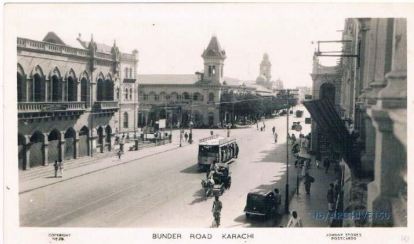The Current State of Built Heritage in Karachi
The Case of Empress Market
Abstract
 Abstract Views: 859
Abstract Views: 859
Modern Karachi has a fragmented and multifaceted social formation, while its historic core presents a diverse range of historical attributes of its built heritage. The increasing urban population of Karachi contributes heavily to its degradation including the degradation of its historical attributes. There is no effective heritage legislation and there are conflicts between what people do and what the government institutions do. Consequently, there is chaos and deterioration in the inner city. The city has been developing rapidly and the government has proposed many projects for the revival of the historic core of the city. However, most of them have not been successful. The objective of this research is to examine the situation in which heritage buildings face a serious threat. The current research focused on one such project, that is, the Empress Market ̶ the restoration and redevelopment of its historic precinct. It adopted physical observations, archival analysis, and site surveys along with photographic documentation and interviews of the local shop dwellers (especially to focus on the historical evolution of the building) as research techniques. The findings showed that the state of deprivation of the historic core of Karachi is the reflection of a collective devastation of the precinct in terms of social and historic values, which is further supported by the non-prevailing heritage legislative system. The research also investigates the present condition of the Empress Market in connection with its glorious past and urban decay befallen to it over time due to vandalism and the numerous restoration plans proposed for it over the years. The study can be beneficial to comprehend the ground realities concerning the survival of heritage properties within the cumulative urbanization process. The results can be used also to propose the rejuvenation of the lost splendor of the historic urban core of Karachi as a prototype for parallel development schemes.
Downloads
References
Baille, A. F. (1890). Kurrachee: Past, present and future (volume II). Pakistan Herald Publications.
Government of Sindh, Housing and Town Planning Department. (2015). Sindh Building and Town Planning Regulations: Preservation of Heritage Buildings. Author
Haroon, H., & Baig, M. A. (2004). Karachi under the Raj 1843‐1947: Visions of Empire. Pakistan Herald Publications.
Hasan, A. (1999). Understanding Karachi, Planning & Reform for the future Karachi. City Press Publication.
Hasan, A., Polak, A. S., & Polak, C. (2008). The Hawkers of Saddar Bazaar. Ushba Publishing International.
Hughes, A.W. (1876). Gazette of the Province of Sindh. George Bell and Sons.
Karachi Metropolitan Corporation (KMC). (2014). Razed encroachments from Empress Market. http://www.zameen.com/news/karachi-metropolitan-corporation-razed-encroachments-fromempress-market.htmlhttp
Larri, Y. (1996a). A time of conserve Karachi’s environmental and cultural heritage. Heritage Foundation.
Larri, Y. (1996b). The Dual City: Karachi during the Raj. Oxford University Press.
Morris, J., & Winchester, S. (1983). Stones of Empire: The building of the Raj. Antony Rowe Ltd.
Ousat, A. (2014a, May 3). Risking history: Experts unimpressed by Empress Market’s new neighbor. The Express Tribune. http://tribune.com.pk/story/703864/riskinghistoryexpertsunimpressedbyempress-markets-new-neighbour/
Ousat, A. (2014b, April 16). Time for a makeover: Saddar to undergo major changes as revival plan kicks off. The Express Tribune. http://tribune.com.pk/story/696623/timefor- a-makeover-saddar-to-undergo-major-changes-as-revival-plan-kicks-off/
Ovais, H. (2013). Community and architecture: Contribution retrospect in Karachi during the British Raj Case of Saddar Bazaar. Journal of Research in Architecture and Planning (JRAP),15(2), 55-73.
Qureshi S. (2010). The fast growing megacity Karachi as a frontier of environmental challenges: Urbanization and contemporary urbanism issues. Journal of Geography and Regional Planning,3(11), 306-321.
Soomro, T. A., & Kumar, R. (2013). Documentation &recording of the forgotten heritage – Case Study of the historic core of Karachi. Paper presented at the ICOMOS International Conference 2013 - The Cases of Forgotten Heritage, Thailand.
Soomro, T. A., & Soomro, M. A. (2018a). Fading legacy of the architectural heritage of the historic core of Karachi. Engineering, Technology & Applied Sciences Research, 2, 41-64.
Soomro, T. A., Soomro, M. A. (2018b). Planning failure of satellite town: A case study of Korangi in Karachi Pakistan. Mehran University Research Journal of Engineering and Technology, 37(1), 209-222.
World Population Review. (n.d.). Karachi population 2020. https://worldpopulationreview.com/world-cities/karachi-population/

Copyright (c) 2020 Tania Ali Soomro, Ayesha Agha Shah, Yasira Naeem Pasha

This work is licensed under a Creative Commons Attribution 4.0 International License.
JAABE follows an open-access publishing policy and full text of all published articles is available free, immediately upon publication of an issue. The journal’s contents are published and distributed under the terms of the Creative Commons Attribution 4.0 International (CC-BY 4.0) license. Thus, the work submitted to the journal implies that it is original, unpublished work of the authors (neither published previously nor accepted/under consideration for publication elsewhere). On acceptance of a manuscript for publication, a corresponding author on the behalf of all co-authors of the manuscript will sign and submit a completed Copyright and Author Consent Form.
Copyright (c) The Authors





